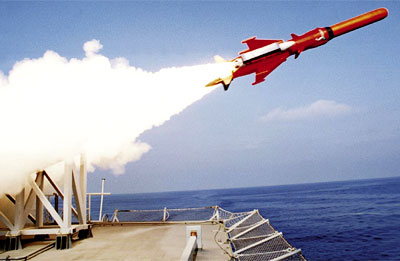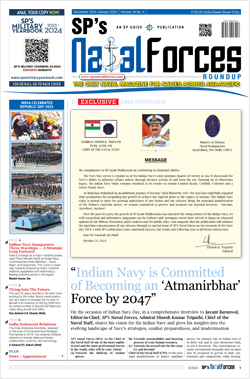INDIAN ARMED FORCES CHIEFS ON OUR RELENTLESS AND FOCUSED PUBLISHING EFFORTS

The insightful articles, inspiring narrations and analytical perspectives presented by the Editorial Team, establish an alluring connect with the reader. My compliments and best wishes to SP Guide Publications.

"Over the past 60 years, the growth of SP Guide Publications has mirrored the rising stature of Indian Navy. Its well-researched and informative magazines on Defence and Aerospace sector have served to shape an educated opinion of our military personnel, policy makers and the public alike. I wish SP's Publication team continued success, fair winds and following seas in all future endeavour!"

Since, its inception in 1964, SP Guide Publications has consistently demonstrated commitment to high-quality journalism in the aerospace and defence sectors, earning a well-deserved reputation as Asia's largest media house in this domain. I wish SP Guide Publications continued success in its pursuit of excellence.
- MoD initiates comprehensive review of Defence Acquisition Procedure 2020, pushes for defence reforms
- G7: The Swansong
- Kalinga Connect: South Asia to Polynesia
- Advanced MRSAM for India for a greater firepower
- Must Credit DRDO for Operation Sindoor, now what is next for defence R&D?
- Operation Sindoor | Day 2 DGMOs Briefing
- Operation Sindoor: Resolute yet Restrained
Anti-Submarine Weapons
Fire Underwater

To render India’s blue print of a regional power a reality, it is essential to developa potent submarine force along with acquiring the most modern, accurate andlethal anti-submarine weapons
An anti-submarine weapon is any weapon that can be used against a submarine to destroy or degrade its capability. Such weapons have to be effective underwater, necessitating application of a whole range of technologies vastly different from that used for surface platforms. The first use of a submarine in combat has been recorded on February 17, 1864 during the American Civil War when the Confederate States Navy vessel CSS Hunley became the first submarine to sink an enemy vessel in combat, the USS Housatonic (1,124 metric tonnes screw sloop). But soon after, Hunley also sank, drowning all eight of its crew. After about 136 years, on August 8, 2000, the wreck was recovered, and the DNA-identified as that of the eight crewmen. Their remains were interred in Charleston’s Magnolia Cemetery with full military honors.
Torpedo tubes were first installed on a submarine around 1885 and the first ship was sunk by a submarine launched torpedo in 1887. With the advent of submarines in naval warfare, the process of developing countermeasures also commenced. During the early stages, a submarine was sunk either by ramming it or by gunfire when it sur-faced. Consequently, it was largely immune to any countermeasures when submerged. During World War I, there were about 400 submarines operating on the high seas. The Germans used their U-Boats very effectively against British merchant fleet, egging UK to desperately hunt for an effective antidote.
Research & Development
Bombs were not found effective but depth charges worked well and were placed on British destroyers. Other techniques used were minefields, barrages and Q-ships. Heavily armed with concealed weapons, Q-ships were merchant ships that acted as a sort of bait for the submarine which surfaced to attack the unarmed merchant but got attacked by it. These systems were very effective as the Germans lost about 178 U-Boats during World War I. Torpedoes were effective but locating a submarine underwater was a problem. However, the Hydrophones had been developed and were becoming effective as detection and locating devices. There was also the acute need for a forward throwing weapon.
During the intervening period of the two World Wars, key developments took place in the field of active sonar (Sound Navigation And Ranging) and radar. The British inte-grated the sonar with fire control and weap-ons to form an integrated system for war-ships. During World War II, Germany revived its submarine warfare and other nations also followed suit, thus the thrust towards anti-submarine weapons also took a fresh impetus. British and Commonwealth Naval Forces proved particularly adept in using depth charges and formed some of the first destroyer hunter-killer groups. Air-dropped depth bombs were normally set to explode at a shallow depth, while the submarine was crash-diving to escape attack. Aircraft were very successful in preventing U-Boat attacks as well as well as destroying them. Some were fitted with a searchlight as well as bombs.
The new weapons developed during this period were as follows:
Forward-throwing anti-submarine mor-tars: Introduced in 1942 to prevent loss of sonar contact, these mortars used a multiple type of small depth charges. The first type of charge created a pattern of underwater explosions around a likely target while the second type exploded only on contact. A subsequent design allowed a destroyer hunting the submarine to maintain continu-ous sonar contact until a kill was achieved.
FIDO (Mk 24 mine) anti-submarine hom-ing torpedo: It was an air-dropped passive acoustic homing anti-submarine torpedo, introduced in 1943 by the US and contribut-ed to many ‘kills’ of the German submarines. Its production was discontinued in 1948.
Cold War phase
Both the US and the Soviet Union strived to develop more lethal and stealthier sub-marines. Thus, the countermeasures also became more lethal and accurate with the introduction of new delivery platforms like the helicopter. The torpedoes were made more accurate and new anti-submarine mis-siles and rockets were developed. Better sensors like improved sonar and Magnetic Anomaly Detectors (MAD) were developed to give ships, submarines and maritime patrol aircraft longer detection capability.





